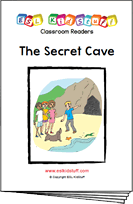Actions – Present continuous lesson plan
Stand-alone lesson ESL kids lesson plan
Lesson plans for ESL kids teachers

Actions – Present continuous
In this lesson students are introduced to the present continuous tense for actions taking place at the time of speaking. They will do lots of energy burning activities, sing a song about actions and make a wall poster.
Members get accompanying worksheets, song and classroom reader.
Download materials:
Our lesson plans are FREE!
Sign up for accompanying:
✔ worksheets
✔ homework sheets
✔ craft sheets
✔ flashcards
✔ song downloads & videos
✔ classroom readers & videos
Click to see lesson details, materials and supplies
Time: 40 mins – 1 hour
Objectives: Using the present continuous tense to talk about activities you are doing now.
Structures: “What are you doing?”, “I am”, “He is”, “She is”, “They are”.
Target vocabulary: running, cooking, eating, swimming, walking, drinking, drawing, sleeping.
Lesson materials
Flashcards:
- run, cook, eat, swim, walk, drink, draw, sleep.
Printables:
- What are you doing 1? worksheet
- What are you doing 2? worksheet
- Reader worksheet
- What are you doing? song poster
Songs:
- What are you doing?
Readers:
- What are you doing?
Additional materials:
- Present continuous vocab crossword
- Present continuous word search
- What are they doing? worksheet
Supplies:
- [hide_on_uk]colored[/hide_on_uk][hide_on_us]coloured[/hide_on_us] pencils
- large sheets of construction paper / card (1 per group of 3 or 4 students)
- old magazines, [hide_on_uk]catalogs[/hide_on_uk][hide_on_us]catalogues[/hide_on_us], newspapers, etc. – anything with pictures of people doing things
- scissors
- glue
- board with marker / chalk
- device to play the song on
This is a great energy burning lesson with lots of actions. It introduces the present continuous tense for actions taking place at the time of speaking.
The present continuous tense (sometimes referred to as the present progressive tense) is often used to talk about a continuing action, something happening now (or at the moment of speaking). It is also used in other situations, such as for temporary events, however, this lesson focuses on the present situation.
The present continuing tense is formed from the present tense to be and the present participle (~ing form) of the main verb:
- Positive: He is drawing a picture (to be “is” + verb-ing)
- Negative: We aren’t sleeping (to be “are” + “not” + verb-ing)
- Wh questions: What are you doing? (Wh question + to be “are” + verb-ing)
- Yes/No questions: Is she playing tennis? (to be “is” + verb-ing)
Lesson procedure:
Warm up and maintenance:
The beginning of your lesson is extremely important: this is where you set the tone of your lesson and get everyone in the right frame of mind for learning English. It is also an opportunity to check homework and review previous lessons.
Click for warm up suggestions for the start of your lessons
These activities can be done in the following order at the start of your lesson:

1. Greetings and name tags
Greet the students by name as they enter the classroom and gesture for them to sit down. Before class prepare some blank name tags (stickers or pin-on tags). Give these out and have everyone write their names and put their tags on. If you use pin-on tags, you can keep and give out every class.

2. Homework check
Check each student’s homework set in the last lesson. Ask each student some questions about their homework worksheet (e.g. “what [hide_on_uk]color[/hide_on_uk][hide_on_us]colour[/hide_on_us] is it?”), give lots of praise, and then put some kind of mark on the homework sheet (e.g. a sticker, a stamp or draw a smiley face). Finally, tell your students to put their homework back into their bags.
3. Review past lessons
Reviewing past lessons is very important – students need constant practice of new vocab, structures, songs, games and so on. Always review parts of your last lesson as well as some parts from other previous lessons. You can spend 5-10 minutes reviewing – it’s fine to recycle games and activities from your past lessons to review as kids enjoy playing familiar games (although be careful not to play a game to death!). See the section “Other ideas to include in your warm” below for ideas.
You can also include review activities in the main body of your lesson. Kids can have short attention spans so it’s good to be able to pull out lots of activities during different stages of the lesson.
Other ideas to include in your warm up:
Ball pass questions
This is good to review questions from previous lessons. Get everybody standing in a circle.
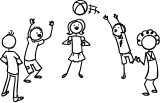
Round 1:
Take a ball and hold it and say, “My name is (you name)”. Then throw the ball to one student and say, “What’s your name?”. Students throw the ball around randomly, saying their names and asking for names.
Round 2:
This time ask a review question, e.g. “How many tables are there?”. Then throw the ball to a student who should answer, “There are (6) tables”. Help if necessary. Then that student throws the ball to another student and asks a “How many …?” question. Continue so everyone has a go. You can have multiple rounds with different topic questions.

Play “Spin the bottle”
Sit students in a circle with a bottle in the middle. Teacher spins the bottle. When it stops spinning the student it is pointing to has to answer a question. If the answer is correct then that student can spin the bottle. This is a good class warm up activity (e.g. How are you? What’s your [hide_on_uk]favorite[/hide_on_uk][hide_on_us]favourite[/hide_on_us] food? How’s the weather today?, etc.
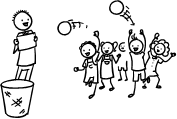
Play “Vocabulary basketball”
This is a fun game which reviews vocabulary from previous lessons. You will need a basket (a trash can) and 2 balls (or 2 pieces of A4 paper scrunched up into balls).
Form 2 teams and line them up so that two players from each team are facing the front with the basket in front of them. Let both players throw their ball – if they get their ball into the basket they can try and win a point by giving the correct answer to a question the teacher asks. This can be an actual question (e.g. What are you wearing?) or a flashcard (What’s this?). Then they go to the back of the line. At the end, the team with the most points is the winner!
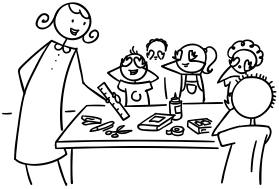
Play “What’s missing?”
This is a fun review memory game – students will have to try to remember review objects from previous lessons (e.g. classroom stationery). Lay the objects out on a table for all to see. Allow the students a minute to memorize the positions of the objects. Remove an object and hold it behind your back. Say, “Open your eyes!” – the first student who can shout out the missing object wins a point for his/her team. Play for all the objects.
Finally, calculate which team has won the most points and give them a round of applause.

Play “Quiz game show”
This is a fun quiz game, like a simple version of a TV game show. Draw some circles on the board and randomly write numbers 1, 2 or 3 in each circle. These will be points.
Put students into teams. Then ask the first team to choose a number – 1 is an easy question (e.g. “Do you like bananas?”) and 3 is a difficult question (e.g. point at a clock and ask, “What time is it?”). 2 will be in between in terms of difficulty. When the question has been answered correctly, erase that number circle. Play until all the number circles are gone – the team with the most points is the winner!
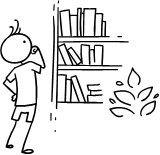
Read a classroom reader again
As you progress through the lessons you will start to build up a catalog of classroom readers (see our Readers download page at https://www.eslkidstuff.com). Kids love going back to old stories and reading through them again. Invite a student to pick a classroom reader and read through it as a class. Make the story as interactive as possible by asking questions (e.g. what [hide_on_uk]colors[/hide_on_uk][hide_on_us]colours[/hide_on_us] there are, the names of different objects, etc.) and getting students to speculate what is going to happen next in the story.

Talk about the weather (do after you have taught the weather lesson plan).
- Prepare a weather board. Before the first class prepare a piece of cardboard and cover it with felt – you are going to pin this to the wall. If you can, try and get blue felt (to represent the sky). Write at the top in large letters, “How’s the weather today?”. Below that write “Today it’s”. Cut out weather pictures (such as our weather flashcards) and stick some velcro on the back. Arrange the weather pictures around the edge of the board and then put the board on the wall of your classroom. You can now use this weather board at the beginning of every lesson.
- Ask about the weather. Ask, “How’s the weather today?” and have students put up their hands. Allow one weather condition per student (e.g. “It’s rainy”) and have each student come up and put a weather picture on the weather board.
- Introduce more weather vocabulary. Depending on weather conditions, you can introduce more weather words (with pictures … you can get students to draw them), such as:
- stormy
- misty
- showery
- freezing
- humid
- frosty
- icy
- drizzly
New learning and practice:
1. Introduce the actions vocab: play “Slowly reveal the flashcard”
Your students should know some of these actions from previous lessons and possibly your warm-up routine (the “Exercise routine” activity). This will be a good review and an introduction to some more common verbs.
Before class prepare the following flashcards: run, cook, eat, swim, walk, drink, draw, sleep. You can also add some more action flashcards to this list for more practice.

Start with the “run” flashcard – place it behind the pack of the other flashcards so your students can’t see the picture. Slowly push the flashcard up, revealing a little of the picture. Encourage students to shout out what they think it is. Keep slowly revealing the image until someone shouts our the correct word (or for new words you will have to tell them the answer). Then chorus the word 3 times. Finally, shout “Ok, everyone run for 5 seconds … 1 – 2 – 3 – 4 – 5 – Stop!” and have everyone run around as you count five seconds.
Then do the same routine with the other flashcards.
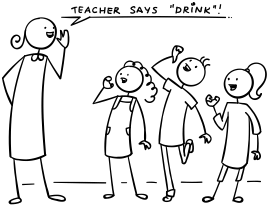
2. Play “Teacher says”
This is the same as the game “Simon says” but with the word “teacher” instead of “Simon”. Line everyone up in front of you and say, “Teacher says drink” and have everyone do the drinking action. Go through a few more verbs with everyone doing the actions. Then say, “sleep” without the “Teacher says” part – anyone who does the action is out! First time, you can give a warning but after that any mistakes result in the student sitting out the round.
3. Introduce the structure – do “Marching chant”
After playing “Teacher says”, keep everyone standing in a line facing you. Place the flashcards on the board in the order of the song (or use the song poster). Model marching on the spot and clapping a slow rhythm and get everybody to copy you – marching on the spot and clapping at an easy pace. Then start the chant in time with the clapping: “What are you doing? – What are you doing? – What are you doing?, etc”. Make it so that everyone echoes your chant:
Teacher (chanting): What are you doing?
Students (echoing): What are you doing?
Teacher (chanting): What are you doing?
Students (echoing): What are you doing?
etc.
Next, insert the first action into your chant and have everyone echo as they march and clap along:
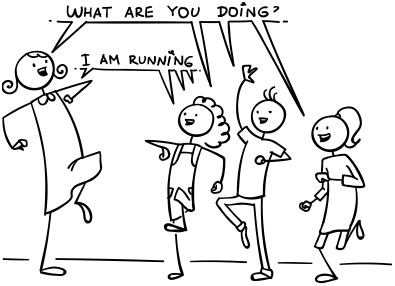
Teacher (chanting): I am running.
Students (echoing): I am running.
Then add more actions into the chant:
Teacher (chanting): What are you doing?
Students (echoing): What are you doing?
Teacher (chanting): I am running.
Students (echoing): I am running.
Teacher (chanting): What are you doing?
Students (echoing): What are you doing?
Teacher (chanting): I am cooking.
Students (echoing): I am cooking.
etc.
You can have some fun by going fast and slow, adjusting the pace of the marching and the chant.
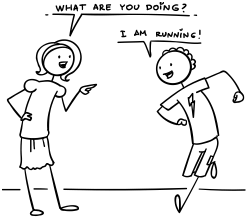
4. Play “What are you doing?” actions
Start by modeling the activity. Get a volunteer to help you. Start running on the spot and have your volunteer say, “What are you doing?” and reply, “I am running!”. Then start doing a cooking action and have the student ask again, “What are you doing?”. Reply, “I am cooking!”. Continue this for all of the verbs, in the order of the song, using the flashcards on the board (or the song poster) as prompts.
Next, pair up your students. Have one doing all of the actions and the other asking, “What are you doing?”. Once finished, students swap roles.
5. Sing the “What are you doing?” song
By now, you will be ready for the song. Play it through one time and have everyone do the actions and encourage them to sing along (see Gestures section below). Use the flashcards on the board or the song poster for prompts.
Then play the song once more for fun.
Lyrics for the “What are you doing?” song
Chorus:
What are you doing?
What are you doing?
What are you doing right now?
Verse 1:
I am running (running!)
I am cooking (cooking!)
I am eating (eating!)
I am swimming (swimming!)
Running, cooking, eating, swimming!
Chorus
Verse 2:
I am walking (walking!)
I am drinking (drinking!)
I am drawing! (drawing!)
I am sleeping! (sleeping!)
Walking, drinking, drawing, sleeping!
Chorus
Verse 3:
I am running (running!)
I am cooking (cooking!)
I am eating (eating!)
I am swimming (swimming!)
Running, cooking, eating, swimming!
Chorus
Verse 4:
I am walking (walking!)
I am drinking (drinking!)
I am drawing! (drawing!)
I am sleeping! (sleeping!)
Walking, drinking, drawing, sleeping!
Gestures for the “What are you doing?” song
Have everyone stand up for the song. We are going to do all of the actions as we sing, so it will be help to have the song poster or flashcards on the board so everyone can see what actions to do:
- during the chorus have everyone march in time with the song (either on the spot or around the classroom, depending on how much space you have available)
- during the verses do the actions of the song
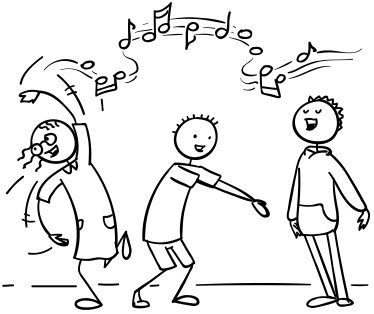
[hide_on_uk]Short sample (members get full-length song):
[/hide_on_uk]
[hide_on_us]Short sample (members get full-length song):
[/hide_on_us]
6. Read classroom reader “What are you doing?”
Let’s follow the song with a reader which uses the structures from the song. Before class, download and print off the reader “What are you doing?”. As you go through each page, point to the pictures and ask your students what they think the people in each picture are doing, for example:
Teacher: (reading from page 1) “What are you doing, Sally?”. What do you think Sally is doing?
Student A: Riding a bike?
Student B: Taking a bath?
Teacher: Hmm, well let’s see … (turning the page) … She’s running! (Reading) “I’m running”.
Some of the pictures are quite straight forward and your students shouldn’t have any trouble guessing but others are not so obvious. Get lots of predictions before checking the answers.
After reading the story, give out a reader worksheet to each student and have everyone write what each person in the story is doing. Then go through the answers as a class.
Alternatively, watch our video version of the reader (Internet connection required).
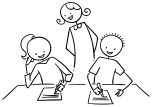
7. Do the “What are you doing 1?” worksheet
Give out the worksheets and circulate as your students match the sentences to the pictures.
8. Teach “I am, He is, She is, They are”
Start by teaching the following structures on the board:
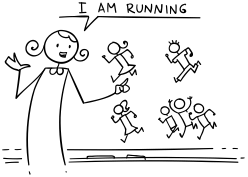
- I am running (draw a stick man / woman running and write your name under the picture)
- He is running (draw a stick man running)
- She is running (draw a stick woman running)
- They are running (draw some stick people running)
Chorus the sentences. Then ask students to come up to the board and draw stick men doing other actions (e.g. “She is drawing”, “They are sleeping”, “He is swimming”, etc.).
9. Do “Magazine cut and paste activity”
Before class you will need to prepare some old magazines, [hide_on_uk]catalogs[/hide_on_uk][hide_on_us]catalogues[/hide_on_us] or newspapers. Anything with pictures of people doing things which you can cut out. The more you can get the better. You’ll also need some large sheets of construction paper.
Start by modeling: hold up a magazine and flick though some pages asking questions about what the people are doing E.g. “What is he doing?” and elicit, “He is walking”, etc. Feel free to choose pictures with other verbs your students might know (e.g. “She is talking”). For each picture you choose, cut it out and stick onto a large piece of construction paper with the following written in marker pen in the middle: “What is he doing? What is she doing? What are they doing?”.
After demonstrating with a few pictures, split your class up into groups – the same number of groups as the number of magazines that you have (3-4 students per group is ideal). Give each group a large sheet of construction paper with the same text written in the middle (“What is he doing? What is she doing? What are they doing?”). Have the groups go through the magazines to cut out and paste pictures of people doing things onto their construction paper. As they are doing so encourage everybody to use the key structures.
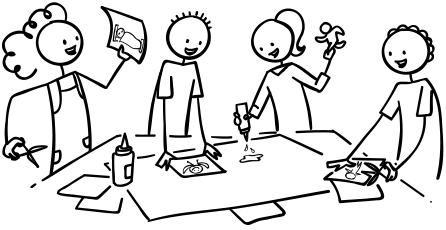
When everyone has finished get one or two students from each group to join a new group. They will then ask questions about the people in the pictures (e.g. “What is she doing?”) and the other members need to reply (e.g. “She is riding a bike”.).
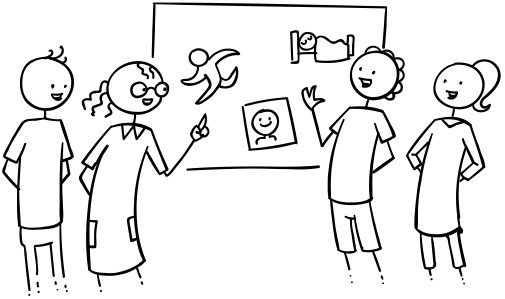
Finally, end this activity by asking questions to each group about their pictures.
Wrap up:
Assign homework: “What are you doing 2?” worksheet
Click for wrap up suggestions for the end of your lessons

1. Assign homework
Each week give out a homework worksheet for your students to take home. Hold up the homework worksheet and model how to do it. Give out the worksheets and say, “Put your homework in your bags”.

2. Do “Quick check”
Time to leave the class. Make sure everything is put away and the students have gathered their belongings. Have them line up at the door and place yourself between the door and the students. For each student check one new word or phrase, for example:
- hold up an object or flashcard (such as an item of clothing) and ask, “What’s this?”
- ask a question from the lesson (e.g. “Where do you live?”, “Do you like bananas?”, “Can you play chess?”, etc.)
When they give you the correct answer say goodbye and let them leave. If their answer is wrong, have them go back to the end of the line – they will have to try again once they reach the front!
Other lesson plans
Actions, verbs & tenses:
- Can – for ability
- Morning routines
- Daily routines & times of the day
- Actions – Present continuous
- Future plans using “going to”
- Past tense activities – Regular verbs
- Past tense activities – Irregular verbs: Part 1
- Past tense activities – Irregular verbs: Part 2
Adjectives:
- Describing people
- Describing things
- Comparing things (Comparative adjectives)
- Comparing things (Superlative adjectives)
Adverbs:
Alphabet:
Animals:
Body:
Classroom:
Clothes:
Colors:
Colours:
Directions:
Family:
Feelings & emotions:
Food:
Health & sickness:
Holidays & festivals:
Jobs:
Likes, dislikes & favorites:
Likes, dislikes & favourites:
- Likes & dislikes
- [hide_on_uk]Favorites[/hide_on_uk][hide_on_us]Favourites[/hide_on_us] and asking why
Nature & Our world:
Numbers:
Places & where we live:
Prepositions of location:
Pronouns:
Shapes:
Shopping:
Sports:
Time, days, months, seasons:
Toys:
Transport & travel:
Weather:





